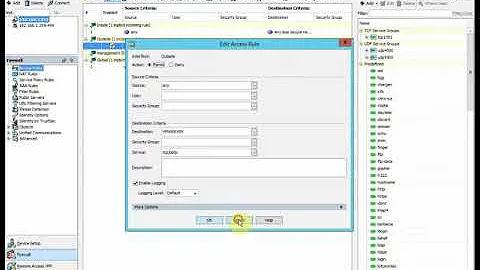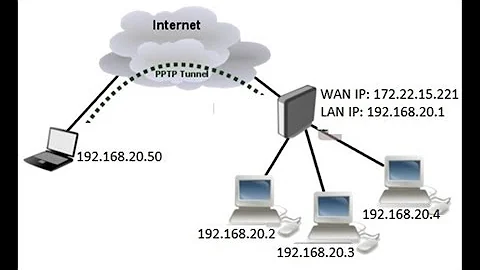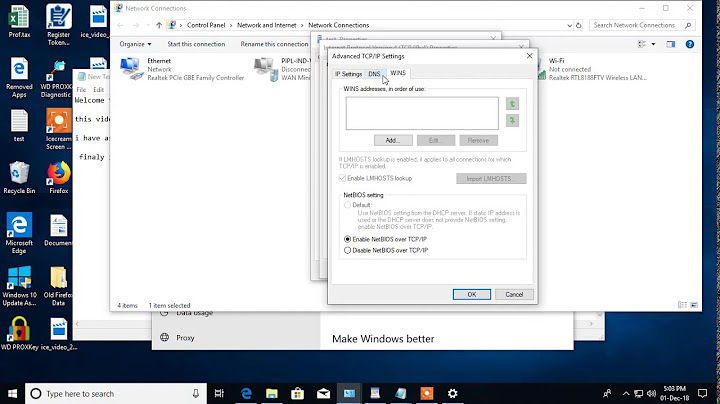VPN (PPTP) connects successfully but unable to ping some devices in the LAN
256
This is because the source address you are using to connect is in a different subnet and/or the APs don't allow packets having more than one hop. To circumvent this you should:
- Connect to the AP via some workstation on the LAN, by getting the remote desktop and using a web browser. This is pretty much the silver bullet.
- If you can't do the above, configure the default gateway on the AP, so it'll send the the traffic originating form outside the LAN to the router (yes, I'm aware of the address scheme you gave, and this will probably not work, because of ARP at play rather than IP routing)
- If this doesn't work, enable the remote access/remote management (or whatever it is called in your AP) in your APs.
Also, the question is, are you going to access those APs on regular basis, or is it just a once-in-a-while configuration?
Related videos on Youtube
Author by
Mohd Atiq
Updated on September 18, 2022Comments
-
Mohd Atiq over 1 year
When I click on the toggle menu it opens properly and then it automatically closes. I don't know why it is happening. I have only a little knowledge of JS.
How can I solve this problem?
My code
if ($('.nav-menu').length) { var $mobile_nav = $('.nav-menu').clone().prop({ class: 'mobile-nav d-lg-none' }); $('body').append($mobile_nav); $('body').prepend('<button type="button" class="mobile-nav-toggle d-lg-none"><i class = "icofont-navigation-menu" > < /i></button > '); $('body').append('<div class="mobile-nav-overly"></div>'); $(document).on('click', '.mobile-nav-toggle', function(e) { $('body').toggleClass('mobile-nav-active'); $('.mobile-nav-toggle i').toggleClass('icofont-navigation-menu icofont-close'); $('.mobile-nav-overly').toggle(); }); $(document).on('click', '.mobile-nav .drop-down > a', function(e) { e.preventDefault(); $(this).next().slideToggle(300); $(this).parent().toggleClass('active'); }); $(document).click(function(e) { var container = $(".mobile-nav, .mobile-nav-toggle"); if (!container.is(e.target) && container.has(e.target).length === 0) { if ($('body').hasClass('mobile-nav-active')) { $('body').removeClass('mobile-nav-active'); $('.mobile-nav-toggle i').toggleClass('icofont-navigation-menu icofont-close'); $('.mobile-nav-overly').fadeOut(); } } }); } else if ($(".mobile-nav, .mobile-nav-toggle").length) { $(".mobile-nav, .mobile-nav-toggle").hide(); }-
 Admin over 8 yearshere is the good explanation, I already try to my pptp server pptpclient.sourceforge.net/routing.phtml#all-to-tunnel now I can shutdown my device from cellphone, all connected to one vpn server
Admin over 8 yearshere is the good explanation, I already try to my pptp server pptpclient.sourceforge.net/routing.phtml#all-to-tunnel now I can shutdown my device from cellphone, all connected to one vpn server -
mplungjan over 2 yearsI made you a snippet Please click edit then scroll down and click "edit above snippet" and add relevant frameworks, CSS and HTML
-
 Faeemazaz Bhanej over 2 yearsEdit code and display
Faeemazaz Bhanej over 2 yearsEdit code and displayHTMLandCSS
-
-
bobo almost 9 yearsWhat you mean is, when my home computer accesses the APs, they see the source IP as my home computer public IP rather than the 192.168.1.253 assigned by the Cisco router? I access these APs on regular basis.
-
 Konrad Gajewski almost 9 yearsNo, they see it as 192.168.1.253 all right, but the APs generally refuse such packets on an IP level if they do not originate from the local network.
Konrad Gajewski almost 9 yearsNo, they see it as 192.168.1.253 all right, but the APs generally refuse such packets on an IP level if they do not originate from the local network. -
bobo almost 9 yearsBut after the VPN packets reach the Cisco router, it will unpack the packets before they reach the APs. So the APs should not know these packets in fact do not originate from the local network. Not true?
-
 Konrad Gajewski almost 9 yearsDo a traceroute to 192.168.1.253 from the local network.
Konrad Gajewski almost 9 yearsDo a traceroute to 192.168.1.253 from the local network. -
bobo almost 9 yearsI still haven't done this test but one thing I can confirm is that, when the access points are put in AP mode (yes, they have router / AP mode), the [allow remote management] tick box in the web admin interface will not be available. It seems it's common for different brands of routers to make this option unavailable when in AP mode. So it seems method 3 is not possible.
-
bobo almost 9 yearsMethod 1 is actually not possible because my working company don't have any workstation. It's a windows WORKGROUP rather than domain environment.
-
bobo almost 9 yearsI have also checked that both APs currently already have default gateway set to
192.168.1.1. -
bobo almost 9 yearsSince the problem is that the VPN IP
192.168.1.253I get is in a different subnet. I am thinking about whether it's possible to do some settings in the Cisco router so that when I request the web admin page, it will request on behalf of me, thereby the access points will see it's192.168.1.1rather than192.168.1.253who requests the page and since it's the same subnet, they should not complain. -
 Konrad Gajewski almost 9 yearsAs a last resort you might switch the WANs on on the APs, create a VLAN on the Cisco (lets say 192.168.0.0/24), and connect them to the via some switch to the router (call it OOB management).
Konrad Gajewski almost 9 yearsAs a last resort you might switch the WANs on on the APs, create a VLAN on the Cisco (lets say 192.168.0.0/24), and connect them to the via some switch to the router (call it OOB management).



![[Mikrotik] PPTP VPN server configuration on Mikrotik](https://i.ytimg.com/vi/8SvfARW469E/hq720.jpg?sqp=-oaymwEcCNAFEJQDSFXyq4qpAw4IARUAAIhCGAFwAcABBg==&rs=AOn4CLC7xtT3bNnuDlvehY0LrlDfYhS7sQ)
